|
Friday, May 17
- Breakfast: strawberry-stuffed French toast
- Breakfast: chorizo and egg burrito
- Texas Pete buffalo-style wings
- Smart cuisine: Hawaiian stir fry
- Tuna noodle casserole
- Honey mustard ham and Swiss panini
- Chicken fajitas plate
- Cream of butternut squash soup
- Texas-style chili
- Assorted pizza by the slice
Wilson Hall Cafe menu
|
|
Friday, May 17
Dinner
Closed
Wednesday, May 22
Lunch
- Salad nicoise
- Frozen blackberry chiffon pie
Chez Leon menu
Call x3524 to make your reservation.
|
|
One minute with Stacey Masters, human resources services manager
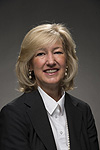 |
|
Stacey Masters
|
How long have you been at Fermilab?
My first day was April 22, so I've been here about three and a half weeks—a short time, but I already feel at home.
What attracted you to the HR services manager position?
I grew up in Warrenville and enjoyed spending a lot of time at Fermilab as a kid—biking on the paths, visiting Wilson Hall and seeing the bison. I've always held Fermilab in the highest regard, so when the position opened up due to Borys Jurkiw's retirement, I jumped at the opportunity. Also, I was working in a similar capacity at the College of DuPage, so the move made sense.
What is a typical day for you like?
I'm still learning the ropes, so right now I've been meeting with a lot of the staff within human resources but hope to get to meet many others outside of HR in the near future! Since I oversee the HR information system, visa services and compensation, I anticipate quite a few challenges in the months ahead. In addition to learning the culture and inner workings of the organization, I understand that summer is a very busy time in the visa services area, which also affects other aspects within the HR realm. Compensation is always a busy area with many upcoming projects, and we are also in the process of acquiring and implementing a new human capital management system.
What do you like best about working in human resources?
I am a people person—that's why I love human resources. My door is always open, and I'm looking forward to getting to know everyone at Fermilab.
What do you like to do for fun?
When I'm not at work, I enjoy spending time with my two daughters. And, after a 15-year hiatus, I recently started golfing again. Music is my true passion and I love getting out to hear live bands on the weekends and attending all of the summer festivals going on throughout the Chicago area.
—Deb Sebastian
If there is an employee you'd like to see profiled in an upcoming issue of Fermilab Today, please e-mail today@fnal.gov.
|
Eagle on the watch
 |
A bald eagle keeps a lookout on a tree near the horse stables by DZero. Photo: Will Messer, AD |
|
Moniz confirmed as Energy Secretary
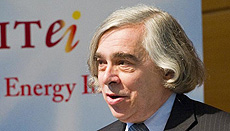 |
The U.S. Senate has unanimously confirmed MIT physics professor Ernest Moniz as the next Secretary of Energy. Photo: Justin Knight
|
Ernest Moniz, an MIT physics professor with extensive experience with particle accelerators and national energy policies, has been confirmed in a unanimous vote by the U.S. Senate as the next Secretary of Energy.
The Department of Energy is the single largest supporter of particle physics and of basic research in the physical sciences in the United States.
Moniz succeeds Steven Chu, also a physicist, who served during the Obama administration's first term and who announced Feb. 1 that he would be stepping down. After the transition, Chu will be joining the faculty of Stanford University.
Coincidentally, Moniz also has a Stanford connection. He earned his Ph.D. in theoretical nuclear physics there in January 1972.
After postdoctoral research stints in Saclay, France, and the University of Pennsylvania, Moniz joined MIT's physics faculty in 1973. He was director of the DOE-funded Bates Linear Accelerator Center from 1983 to 1991. In the 1990s, Moniz became more active in the national energy policy discussion. He served the Clinton Administration as associate director for science in the White House's Office of Science and Technology Policy (1995-97) and then as DOE undersecretary (1997-2001). In 2006, he was named director of the MIT Energy Initiative and the Laboratory for Energy and the Environment.
"Taken together, these roles have given me a deep appreciation of DOE's importance to American leadership in science," Moniz said in his April 9 written statement to the Senate committee reviewing his nomination. "DOE is the lead funder of basic research in the physical sciences and provides the national research community with unique research opportunities at major facilities for nuclear and particle physics, energy science, materials research and discovery, large-scale computation and other disciplines. DOE operates an unparalleled national laboratory system and partners with both university and industry at the research frontier."
Read more
—Mike Ross
|
DIANA chooses Sanford Lab
From Sanford Underground Research Laboratory's Deep Thoughts, May 13, 2013
The DIANA scientific collaboration has chosen the Sanford Lab as the preferred site for the Dual Ion
Accelerators for Nuclear Astrophysics experiment. The news came last week to Sanford Lab Director Mike Headley
from University of Notre Dame physicist Michael Wiescher.
Read more |
|
Seeing the invisible
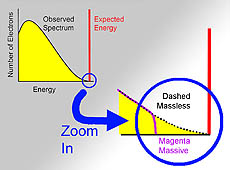 |
| When scientists were first studying beta decay, they expected the electron to be emitted with a single unique energy, as depicted in red. However, they measured instead a range of energies for the emitted electron, shown in yellow, all lower than the expected energy, which the electron would carry if neutrinos didn't exist. In the lower right hand corner, we see a closeup of the spectrum near the expected energy. The dashed line is what we see if the neutrino has no mass, while the magenta curve is what we'd see if the neutrino had a small but non-zero mass. CMS scientists employed this technique to study top quark production to validate the method. |
The world of particle physics and cosmology is full of invisible phenomena like dark matter, neutrinos and that latest spiffy object predicted by the theory of the week. When you think about it, it's really quite hard to measure some of the properties of these invisible particles. So scientists had to come up with some clever ways to determine things like the mass of something that cannot be detected directly. One such way involves careful accounting of the energy observed in the experiment.
This technique has been used in the past. A type of radioactivity called beta decay occurs when a neutron in the nucleus of an atom converts to a proton and emits an electron. Following the principle of energy conservation, scientists predicted the electron to be emitted with a single energy, but measurements showed that the energy of the electron can have many different values. In fact, it turned out that the predicted value of the electron's energy was actually the maximum it could be. The measured values were always lower.
In 1930 Wolfgang Pauli proposed a solution to this curious situation: Not only were a proton and an electron emitted in beta decay, but a neutrino was emitted as well. Neutrinos are particles that interact only via the weak nuclear force and are therefore very, very hard to detect. Clyde Cowan and Frederick Reines showed the idea to be correct in 1955 when the neutrino was detected.
Once it was understood that beta decay involved three—not two—emitted particles, scientists could use energy conservation to determine the mass of the third, the neutrino. The energy of the beta decay can go into six things. Given that energy and mass are equivalent, three of those things are the masses of the proton, electron and neutrino. The other three are their motion energies. We can measure the mass and motion energy for the proton and electron, so the unknowns are the mass and motion energy of the neutrino. To determine the mass of the neutrino, we determine the maximum motion energy carried by the electron, which occurs when the neutrino has no motion energy. Any leftover energy from the decay is the mass of the neutrino.
This technique is not uniquely applicable to beta decay. At CMS, we search for collisions in which supersymmetric particles are created. Many supersymmetric particles are invisible in ways similar to the neutrinos of beta decay, leading researchers to apply this old idea to a new situation.
In order to evaluate how well this technique works in the CMS environment, scientists tried to validate it by using the large sample of top quarks produced at the LHC. Top quarks decay into W bosons and bottom quarks. In some instances, the ephemeral W bosons decay into a neutrino and an associated electron or muon. In such events, the top quark, W boson and neutrinos are not observed. This study was able to extract values for the mass of the top quark, W boson and neutrino and validated the technique. Scientists now have some insight into how well it would work for a search for new physics.
—Don Lincoln
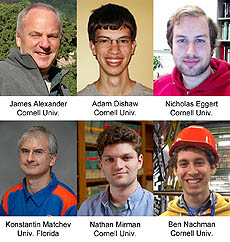 |
| These US CMS scientists contributed to this analysis. |
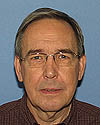 |
| Fermilab's Jim Hanlon will retire after spending about two decades working on the CMS project, most recently as the US CMS Resource Manager. He will be sorely missed. |
|
|